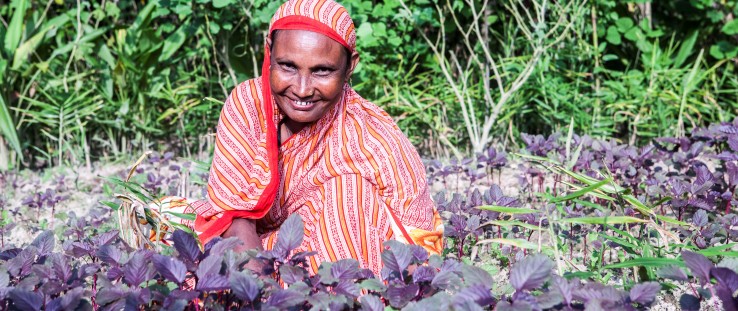 Shafia Begum works on her vegetable plantation near her home in Langurpar village, Sreemongol district.
Wahid Adnan
Shafia Begum works on her vegetable plantation near her home in Langurpar village, Sreemongol district.
Wahid Adnan
 Shafia Begum works on her vegetable plantation near her home in Langurpar village, Sreemongol district.
Wahid Adnan
Shafia Begum works on her vegetable plantation near her home in Langurpar village, Sreemongol district.
Wahid Adnan
Nature holds a sentimental place in the hearts of the people of Bangladesh. In fact, the national anthem “Sonar Bangla,” which means golden Bengal and was written by the late Nobel Prize Laureate and environment enthusiast Rabindranath Tagore, is a rhapsody of praise for the country’s natural landscape. The impact of Tagore and his poetry on Bangladeshi culture is massive, and has cultivated a deep appreciation for the forest, fields, birds, flowers and animals of the golden Bengal.
Some of Bangladesh’s poorest and most vulnerable populations live on the fringes of forests, wetlands and other protected areas. These communities often exploit natural resources for their livelihood. Over time, unregulated extraction of resources has contributed to the loss or degradation of 90 percent of the nation’s forests.
Take, for example, Lawachara National Park, one of Bangladesh’s largest national parks and forested areas. Located in northeastern Bangladesh, where the topography begins to rise from floodplain into gently rolling foothills, the forest of Lawachara is home to an array of flora and fauna, including the largest remaining population of the critically endangered hoolock gibbon.
With its vast groves of evergreens, bamboo and fig trees, Lawachara is also a major source for firewood collection and animal hunting for the communities living in these areas.
Shafia Begum, a married mother of four, lives in the village of Langurpar, which borders Lawachara.
With less than an acre of land for growing rice, Begum—like many in her village—relied on collecting tree trunks, branches, bark and twigs in and around the national park to use as firewood for cooking. She also sold her wood in her neighborhood market to supplement her family’s income.
“I used to sell firewood to other villagers, and used the rest for my own home to cook food. It was a difficult job and provided very little income,” says Begum.
For nearly two decades, USAID has revolutionized a new approach to protecting forests—including Lawachara National Park—and other wetlands and ecosystems in the country. Village committees and the Bangladesh Forest Department come together to monitor protected areas and prevent logging, poaching or other illegal activities. USAID also teaches people living in these areas new skills to earn money and provide for their families while reducing their reliance on natural resources collected from these areas.
“Natural resource conservation is a particularly difficult challenge in Bangladesh, one of the most densely populated countries in the world with tens of millions of people living under the international poverty line,” said Karl Wurster, who oversees USAID programs on environmental conservation and global climate change. “People who live around forests in Bangladesh know the forests are shrinking, but also how important the forests are for their survival.
“Poor people depend on the forests for their income, food and building materials, but frequently they are left with few other options. Our challenge is to help them develop options that allow them to take pressure off the forests and raise themselves out of poverty.”
One alternative to the forest is homestead farming. Begum and families like hers learn to grow nutritious vegetables and other crops on small plots of land that they already own—usually next to or nearby their homes. The crops feed their families and are sold in local markets to make additional money. Some farmers learn how to harvest fish in household ponds or raise chickens, ducks and other livestock. USAID helps individuals and families learn to use higher-yielding seeds and new cultivation techniques to operate homestead farms more efficiently and maximize their production.
Begum learned to cultivate fruits and vegetables like bitter gourd, eggplant, cucumber, pumpkin, bottle gourd, chili, okra and red amaranth. She also learned to maximize her yields by using higher-quality seeds, organic pesticide and composting techniques.
In a country where rampant overuse of pesticides (some farmers admit to spraying their fields as many as 100 to 150 times during each three-month growing cycle) and prevalence of toxic chemical preservatives are causing significantly heightened public concern over food safety, Begum has capitalized on a market looking for safe, nutritious vegetables to feed families.
“I had no idea or understanding of the damage done to the forest by taking wood out of the forests. But we were poor and we have four children to feed, so we thought we had no choice. I also never thought it would be possible to make more money growing vegetables,” she said.
Demand for her organic vegetables has skyrocketed, enabling Begum to sell her produce at a premium price. Compared to farmers selling produce using traditional cultivation methods, fertilizers and pesticides, Begum’s organic produce garners an extra 20 to 30 percent above market value, approximately 10-12 taka (13-15 cents) more per kilogram.
“Now buyers come to my house and pre-book vegetables offering a higher price than the market just because I produce poison-free vegetables,” says Begum.
USAID has significantly expanded its support for poverty reduction and climate resilience for poor communities like those near Lawachara National Park as well as places like the Sundarbans—the largest mangrove forest in the world and a UNESCO World Heritage Site. The focus has expanded beyond co-management of natural resources to include improving fishing and agricultural practices, and building new trades and skills like vegetable cultivation, fish culture and duck rearing. These not only increase incomes, but help to empower women producers.
“This is one of the ways USAID brings together an approach that builds resilience and helps people escape extreme poverty,” says Wurster. “At the same time, co-management and conservation efforts are equally important to protect critical ecosystems like forests and wetlands, which are vital to helping Bangladesh reduce carbon emissions and cut down greenhouse gases that contribute to the effects of climate change.”
While many of the Bangladeshis in the program may not fully realize the positive impact of their efforts on saving the environment, the economic impact is not lost on anyone.
Now, neither Begum nor her family members go to the forest to collect firewood. Through her homestead garden, she earns more than enough to support her family’s household needs and doesn’t have to ask her husband for money.
Her family is eating more nutritiously and Begum no longer needs to buy vegetables at the market. This saves her family 1,500 Bangladesh taka, or approximately $20 each month. On the surface, that may not appear to be a significant amount, but for poor families in rural Bangladesh, it can mean the difference between living in extreme poverty or living more comfortably.
In Langurpar village, many women like Begum receive training and support from USAID. And many of them use the financial savings to pay for their children’s educations.
As Shafia Begum and her family realize their dream of a brighter future, Tagore’s national anthem written at the turn of the 20th century—with its poetic musings of people living in harmony with their environment—lives on in the 21st century.
Related Links
USAID's Environment and Global Climate Change Work in Bangladesh








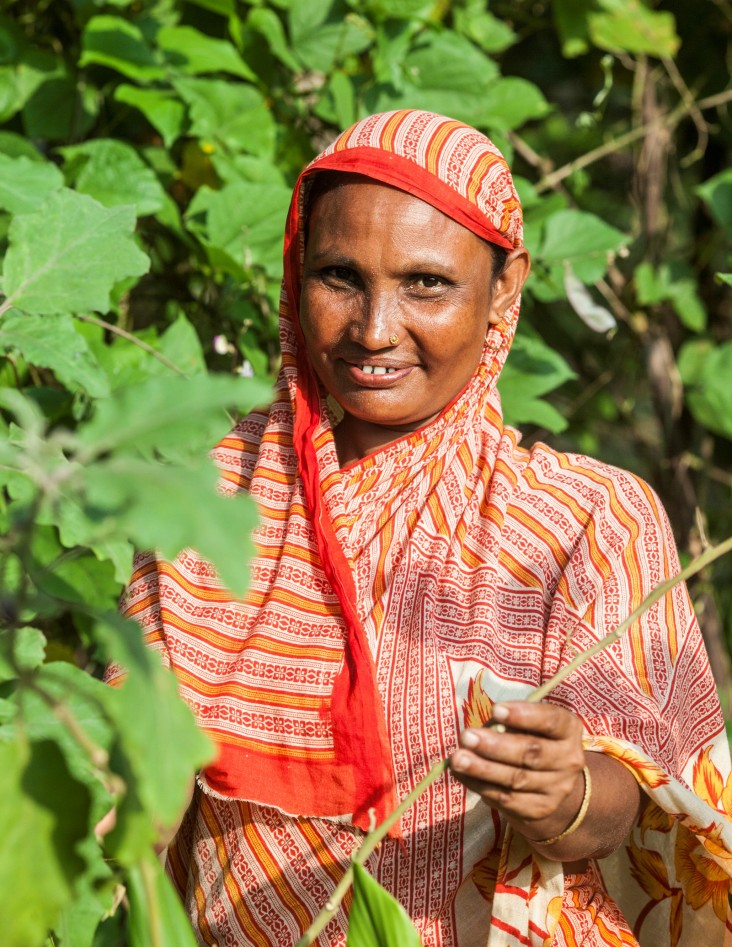
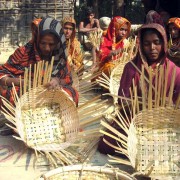
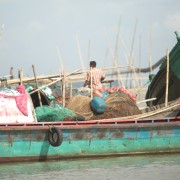
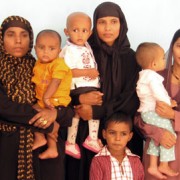
Comment
Make a general inquiry or suggest an improvement.